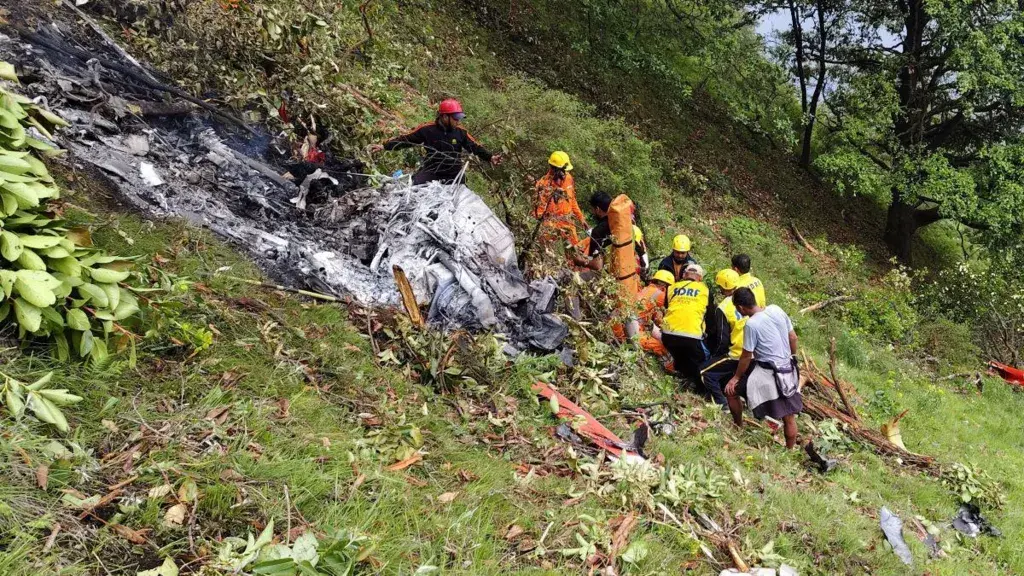Fatal Helicopter Crash in Uttarakhand
On the morning of June 15, 2025, a Bell 407 helicopter operated by Aryan Aviation tragically crashed near Gaurikund in the northern Indian state of Uttarakhand. The helicopter, which was returning from Kedarnath and heading toward Guptkashi, went down shortly after takeoff at approximately 5:20 a.m. local time. All seven people on board were killed, including five adult pilgrims, a 2-year-old child, and the pilot.
The victims’ bodies were recovered from the crash site in a forested mountainous area. According to officials, the aircraft caught fire upon impact, making identification difficult. The Directorate General of Civil Aviation has confirmed that the Aircraft Accident Investigation Bureau (AAIB) has launched a formal probe into the crash.
Identities of the Victims
Among those killed was the pilot, Lieutenant Colonel (Retd.) Rajveer Singh Chauhan, a decorated Army veteran who had only recently transitioned into civilian aviation. Chauhan had retired after 14 years of service and was scheduled to return home later this month to celebrate the birth of his twin sons.

The crash also claimed the lives of a family from Maharashtra: Rajkumar Jaiswal, a well-known coal businessman; his wife, Shraddha; and their 23-month-old daughter, Kashi. Jaiswal had embarked on the Char Dham Yatra with his family as part of a long-awaited spiritual journey. Their elder son, who was in a hostel, and younger son, who had stayed back with relatives, survived by not being part of the trip.
Three additional passengers—elderly pilgrim Vinod Devi, her granddaughter Trishti Singh, and a temple worker named Vikram Rawat—were also among the deceased.
Cause Under Investigation
Initial reports suggest that adverse weather conditions, including heavy fog and poor visibility, may have contributed to the crash. According to officials in Uttarakhand, flights were halted the previous day due to inclement weather and only resumed early Sunday morning.
The state government has suspended Aryan Aviation’s operations on the Char Dham route and launched an internal inquiry into potential lapses in judgment, including whether proper weather assessments were made before flight clearance was given. Authorities have also filed a preliminary case of culpable homicide against the operator.
Government Response and Aviation Review
Uttarakhand Chief Minister Pushkar Singh Dhami called the incident a “deeply saddening tragedy” and has ordered a full safety review of helicopter services across the region. A centralized command and coordination center is being established in Dehradun to monitor all helicopter flights and ensure better communication between operators and regulators.
Furthermore, the state government has mandated a new Standard Operating Procedure (SOP) for all commercial helicopter flights, including rigorous pilot vetting and enhanced pre-flight safety protocols. The Char Dham Yatra’s aerial services have been halted until at least the following Monday as a safety audit is conducted.
A Pattern of Incidents
This crash marks the third major aviation-related incident in Uttarakhand in less than two months. Officials reported that there have been three emergency landings and two crashes along the Char Dham route in recent weeks, prompting urgent calls for stronger oversight.

Helicopter services have grown increasingly popular for transporting pilgrims to the high-altitude Hindu shrines of Kedarnath, Badrinath, Yamunotri, and Gangotri. However, the challenging terrain and unpredictable weather patterns of the Himalayas pose ongoing risks to aerial operations.
Personal Stories
The tragedy has left families shattered across India. The Chauhan family in Jaipur, who had been planning a celebration for their twin sons’ arrival, now mourns the untimely loss of a father and son. In a separate turn of fate, a Maharashtra couple who gave up their helicopter seats to an elderly woman and her ailing granddaughter survived, while their relatives—who took the next flight—perished in the crash.
These stories of loss and survival underscore the fragile nature of life in high-risk environments and highlight the need for comprehensive reforms in regional aviation safety.


